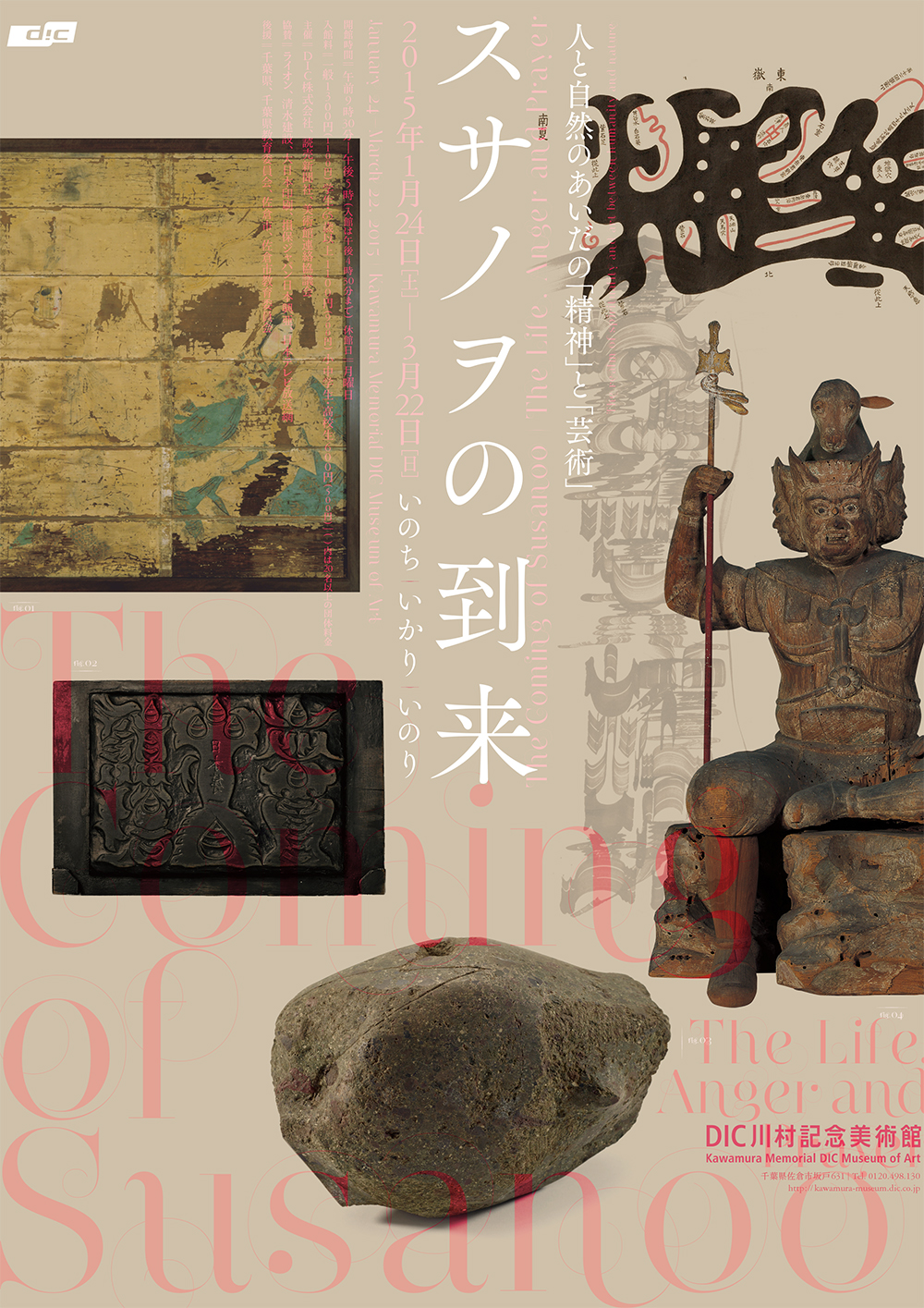The Coming of Susanoo: The Life, Anger and Prayer
The realm of spirituality and art between humanity and nature
January 24 - March 22, 2015
- Hours:
- 9:30-17:00 (last admission 16:30)
- Closed:
- Mondays
- Organizer:
- DIC Corporation, The Yomiuri Shimbun, The Japan Association of Art Museums
- Sponsors:
- Lion Corporation, Shimizu Corporation, Dai Nippon Printing Co., Ltd., Sompo Japan Nipponcoa Insurance Inc., Nippon Television Network Corporation
- Patrons:
- Chiba Prefecture, Chiba Prefectural Board of Education, Sakura City, Sakura City Board of Education
Museum Admission
- Adults ¥1,300
- College / 65 and over ¥1,100
- Elem / JH / HS ¥600
Groups of 20 or more:
- Adults ¥1,100
- College / 65 and over ¥900
- Elem / JH / HS ¥500
Persons with a disability pass:
- Adults ¥1,000
- College / 65 and over ¥800
- Elem / JH / HS ¥400
*Admission also includes entrance to the permanent collection galleries.
- For students and seniors over 65, discounts require identification such as a Student ID, passport or driver's license.
- For persons with a disability pass=the same discounted price applies for one accompanying care-giver for each disability pass holder
Outline
Since ancient times, the human race has developed rich spirituality inspired by the natural world. Spiritual aspects of nature and the gods have also been important themes in the arts. In Japan, the people have lived in an intimate relationship with the natural world since ancient times, and when one studies the Kojiki (Record of Ancient Matters, ca. 712 AD) and the Nihon Shoki (The Chronicles of Japan, ca. 720 AD), they reveal Susanoo as the representative deity symbolizing the relationship between humankind and nature.
Susanoo traditionally has an image as a savage god (Araburu Kami) but is also a god associated with sublime aesthetic sensitivities that made him the originator of waka poetry, and as one that creates new culture by returning things to their original state. With the power to evoke the essence of things, the power to initiate reversals in the existing state of things and the power to inspire artists, Susanoo has long been an important source of ideas and inspiration in times of transition.
In this exhibition, we explore Susanoo-inspired artistic expression that provides renewed visions of the deep spiritual realm that lies between human beings and that which transcends nature and the intellect, in search of new understanding of art as it exists today.
The exhibition begins with earthenware figures from Japan's prehistoric Jomon Period and proceeds to historical materials concerning images of the gods, materials concerning the literary art of figures like Matsuo Basho and the priest Enku, as well as the work of great scholars of the past such as Hirata Atsutane, Tanaka Shozo, Minakata Kumagusu and Orikuchi Shinobu (illustrations from studies concerning the spirit world and ghosts, etc., color illustrations of fungi and other writings). Finally, it goes on to works of contemporary artists such as Okamoto Taro, Wakabayashi Isamu and others who sought to explore and reveal the spirit of Susanoo.
In addition, the entire museum, including exhibits in the permanent collection galleries, will be used to offer a broad range of references to the spiritual world of the East and West in hopes of inspiring new insights and deepened understanding of works of art.
From the DIC collection:
The natural world and mythology have long been important themes in Western art as well, as we can see from works of art in our museum's collection. Works like Aristide Maillol's Venus and Bourdelle's Fruit take a goddess of Roman mythology as their subject, while the subject of Chagall's King David's Dream is a Jewish king from the Old Testament. Also, Kandinsky is an artist whose work is strongly influenced by the world of mythology and spiritualist thought. Mark Rothko is another artist whose studies of mythology and symbols in ancient art became the inspiration for many of his early works and later contributed to his development of a unique artistic world.
The exhibition “The Coming of Susanoo – The Life, Anger and Prayer” has been planned to include displays of works from the museum's collection. As part of this, a special exhibit of the representative sculptural work of Wakabayashi Isamu, Oscillating Scale will be on view this time. We hope this exhibition will offer new insights regarding the art works in the collection when viewed in terms of differing forms of expression in Eastern and Western art.
Lectures
Registration from 13:00 on lecture day.
Receive a lecture ticket at the museum reception desk (limited to first 60 people).
Lecture free with museum admission.
The Quest for and Expressions of Susanoo
– Considerations on the explosive proliferation
Lecturer: Kamata Toji ( Prof., Kokoro Research Center, Kyoto University )
Sunday, February 1, 14:00-15:30
Susanoo Mythology – Toward Extremes in Interpretation
Lecturer: Kawashima Kenji ( Folklore Researcher )
Saturday, March 21, 14:00-15:30
Workshops
“Maika” – Making smelling salts
Seasonal plants and raw salt are used to make your own original moist potpourri
Instructor: Tochigi Miho
Saturday, February 28, 14:00-16:00
Reservations required|Limited to first 15 people|Workshop free with museum admission
The Gestures of Prayer – A workshop in word-making
Photographs of reflective water surfaces from 48 locations provide the source for the birth of new words.
Instructor: Takayuki Obana
Sunday, March 15, 14:00-16:00
Reservations required|Limited to first 20 people|Workshop free with museum admission
Gallery Talks
Gallery Talks by the curator
The curator of the Susanoo exhibition, Yuuki Akamatsu talks about the exhibition in the galleries. Gather at Entrance Hall, no reservations needed.
Saturday, February 21
Saturday, March 7
14:00-15:00
Guided Tours
Tours of the permanent collection and the Susanoo exhibition by guide staff.
14:00-15:00 daily except on days of lectures, curator gallery talks and workshops.
Gather at Entrance Hall, no reservations needed
